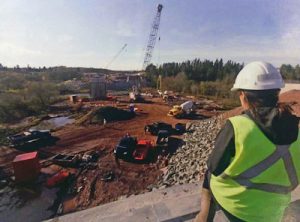

The province is responsible for maintaining the majority of public roods in Nova Scotia. PHOTO: Province of Nova Scotia
A stretch of Nova Scotia’s Highway 101 connects the town of Mount Uniacke – about 40 kilometres North of Halifax – to the community of Ellershouse.
The 11-kilometre highway is one of three concrete roads in the province, tendered in 2003 as part of a $27 million project to twin 21 kilometres of the two-lane road.
St. Lawrence Cement, now CRH Canada Group, was awarded a $5.9 million contract to pave the concrete section in April 2003.
Now in its 15th year, the highway will undergo maintenance as part of the province’s Five Year Highway Plan. This work will take the road to its full life expectancy of 30 to 40 years, a span two times greater than asphalt – but this isn’t the only perk of concrete.
According to the Cement Association of Canada (CAC) – a national organization that promotes the use of concrete in construction – it is also resilient to harsh weather conditions, a key advantage for one of Canada’s most easterly provinces.
Over a 50-year period, a concrete road requires only a third of the maintenance of an asphalt road, according to Michael McSweeney, CAC president and CEO.
Still, despite the success of Highway 101, there hasn’t been another concrete road project in Nova Scotia.
“That’s probably a functionality of the availability of equipment and manpower or skillset from out of province contractors,” says Don Maillet, executive director of Highway Engineering and Construction for the Province of Nova Scotia.
In Nova Scotia, the department of transportation will typically put out a call for bids on major road construction projects in asphalt. Less frequently, it will call for a “national concrete alternative,” which allows for both asphalt and concrete bids.
Maillet says the frequency of an alternate tender depends on the amount of major road construction the province undergoes in the run of a season. When the department does receive a concrete bid, it will perform an initial lifecycle cost analysis. This analysis accounts for the market value of asphalt pavement at the time of project closure and the design and materials of the sub-base and sub-grade.
Adding to the costs, the skillset and equipment for concrete roads has to come from out of province, which produces significant mobilization charges, says Maillet. This generally raises concrete to a higher premium – typically 10 to 20 per cent more expensive.
But a multi-million dollar investment by ready mix concrete producers and contractors will require a guarantee from the province that contracts will be awarded to concrete construction, says Jamie Reed, president of the Atlantic Concrete Association (ACA).
ACA is a not-for-profit, membership-based organization located in Halifax, with a mandate to represent the concrete industry in Atlantic Canada.
THE CHICKEN AND THE EGG
“The sticking point is the equipment to place the concrete is not owned by any company in Atlantic Canada so it’s the ‘chicken and egg’ story,” says Reed.
Specifying roads in asphalt has excluded concrete contractors from the bidding process, says McSweeney. Even more, the procurement process does not encourage competition between paving materials, which he says can lower prices and improve quality.
“This focus on initial cost is deeply flawed because it doesn’t consider the long-term cost of the project, including maintenance and rehabilitation costs, where concrete is almost always significantly cheaper,” says McSweeney.
McSweeney says the federal government has been willing to consider that federal infrastructure dollars undergo a “three-screen” assessment – recently adopted in Ontario’s Long-Term Infrastructure Plan.
This three-screen approach should naturally lead to a procurement process that allows for competition between paving materials, he says. However, it hasn’t yet been introduced in Atlantic Canada.
THE FUTURE OF CONCRETE ROADS
“The technical advancements in concrete placement and road construction (have) evolved over the last 40 years at a great pace,” says Reed.
He says concrete roads offer economical benefits to concrete producers and contractors, as well as taxpayers in Atlantic Canada.
In order to increase the number of concrete roads, McSweeney says a new process that takes into account the full economic and environmental impact of construction, maintenance and rehabilitation will be necessary.
“We love the product,” says Maillet. “It’s done very well for us here in Nova Scotia, but I think it’s a very dynamic situation.”
Still, he says the province does plan on calling concrete alternative projects in the future.
“If the province is serious about more concrete highways the equipment, contractors and experienced personnel will be made available in not just Nova Scotia but all Atlantic Canada,” says Reed.
This article appealed in the April 2018 Issue of On-Site Magazine.
An earlier version of this article stated that St. Lawrence Cement is now LafargeHolcim. This has been corrected to identify the company as CRH Canada Group.




